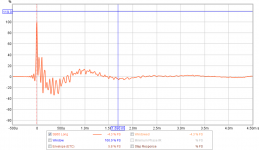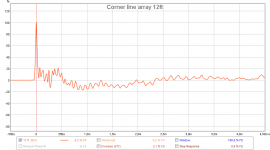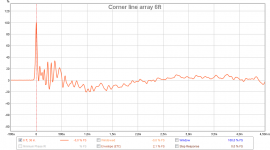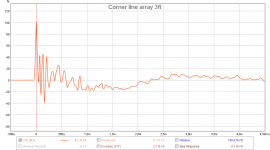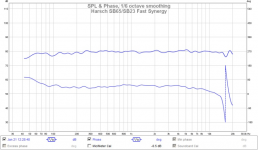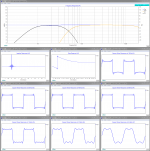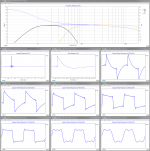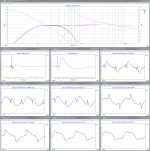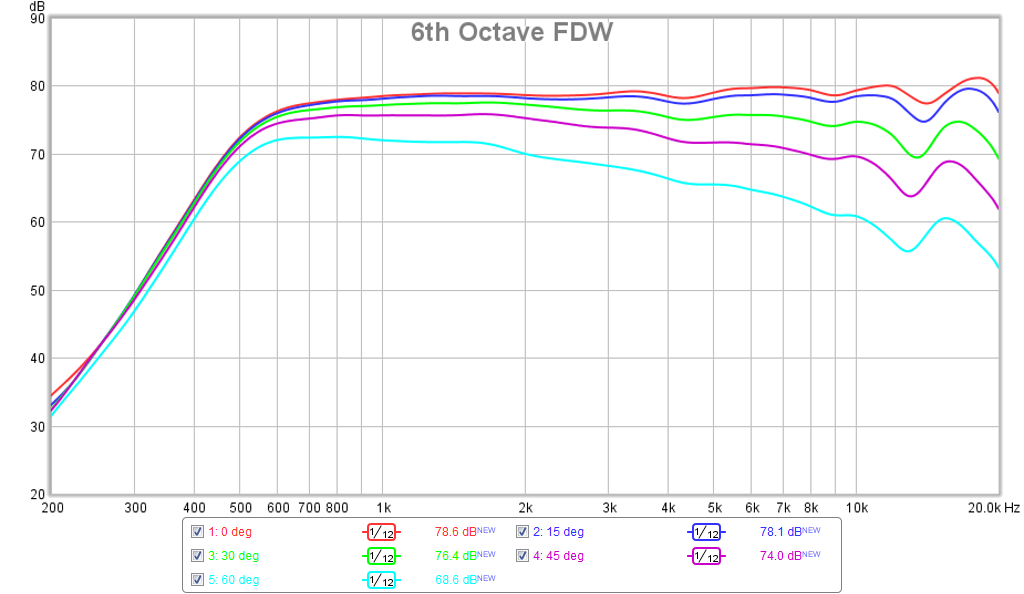Well I hoped people would follow the same road as me - but it seems most have chosen different horn/driver combinations.
I was getting worried everyone would run into problems and the original concept I am trying to build would get somewhat lost!
I would have but the XT1464 is just too pricey to play with here. I agree that if people want optimal results with the benefits of the lessons learned by Bushmeister - get the XT1464 and the SB65. Driver substitutions for this particular speaker seems not to be a wise thing to do unless you enjoy wasting time like I did 😀
I should have realized it because on the uTrynergy, I went from W2-852SH to SB65 and it worked better. It may be that the SB65 has those 5 stiffening ribs in the cone combined with a polymer damping dustcap.
xrk971, great progress with Faital horn after your hard work.
Regarding woofers guess you picked DC200-8 because SB23NRXS45-8 is costly at $92 in US area, maybe there is a middle way in 22W/8534 at $79 because when modeled it seems perform as SB23NRXS45-8 when sitting inside symmetrical band pass, then only unknown is if it is as good in HD specs.
wesayso, xrk971's latest IR reminds me corner loaded arrays from other thread, first below is (post 518) SB65 in Faital horn then CLA 12/6/3 at ft.
bushmeister, noticed SB65WBAC25-4 was at €20 discount at Intertechnik so they got in basket to be ready clone your build : )
EDIT Also look forward what comes out of weltersys post 500 investigations.
Regarding woofers guess you picked DC200-8 because SB23NRXS45-8 is costly at $92 in US area, maybe there is a middle way in 22W/8534 at $79 because when modeled it seems perform as SB23NRXS45-8 when sitting inside symmetrical band pass, then only unknown is if it is as good in HD specs.
wesayso, xrk971's latest IR reminds me corner loaded arrays from other thread, first below is (post 518) SB65 in Faital horn then CLA 12/6/3 at ft.
bushmeister, noticed SB65WBAC25-4 was at €20 discount at Intertechnik so they got in basket to be ready clone your build : )
EDIT Also look forward what comes out of weltersys post 500 investigations.
Attachments
Last edited:
BYRTT true! But even the FR curve has similarities, the dropping FR from the SB65 and the equally drop in FR from the corner arrays.
Can't wait to see the IR again after some EQ.
Can't wait to see the IR again after some EQ.
Byrtt,
I am sure all of those woofers are nice but I have had great luck in past with Dayton classic series for performance vs price. At $25 ea they will let me explore this new horn and if promising then provides an upgrade path later.
You are right about the IR and the responses looking similar. I will try to get miniDSP hooked up and some EQ going soon. My HD crash on main audio data acq system has been a real pain.
I am sure all of those woofers are nice but I have had great luck in past with Dayton classic series for performance vs price. At $25 ea they will let me explore this new horn and if promising then provides an upgrade path later.
You are right about the IR and the responses looking similar. I will try to get miniDSP hooked up and some EQ going soon. My HD crash on main audio data acq system has been a real pain.
I am still trying to find an easy way to mount the woofers.
Plywood panel tacked onto plastic horn wall with hot melt glue. Add a few custom made angled blocks to provide mechanical support to prevent rocking. Build up a containment wall or "dam" with foam core boards. Seal off all edges so that a mixture of plaster of Paris can be poured in. Once plaster hardens it will shrink. Back fill gaps with liquid nails injected into gap.
I just hate working with polyester resin. It's a mess. I suppose expanding foam can work but doesn't feel solid.
Plywood panel tacked onto plastic horn wall with hot melt glue. Add a few custom made angled blocks to provide mechanical support to prevent rocking. Build up a containment wall or "dam" with foam core boards. Seal off all edges so that a mixture of plaster of Paris can be poured in. Once plaster hardens it will shrink. Back fill gaps with liquid nails injected into gap.
I just hate working with polyester resin. It's a mess. I suppose expanding foam can work but doesn't feel solid.
Last edited:
.....Wesayso and X - you were right, listening to some pieces of music with the flat phase and excellent step response makes a definite audible improvement - I found particularly with plucked strings and percussion. Plus I think the well behaved CD makes details much more discernible......
Some visuals and think below show some light on what perceived for plucked strings and percussions, in my view its some track dependent but really adds realism that attack and decay pattern get a boost to better replicate textbook wave shapes.
All four plots are system band pass BW2 80Hz - BW2 22kHz to model your XT1464 point source on design axis but without a sub so SQ-waves in lows will miss DC component power.
Picture 1: XT1464 point source with IRR LR4 500Hz XO and system stop bands as minimum phase (IRR).
Picture 2: XT1464 point source with IRR HARSCH 500Hz XO and system stop bands as minimum phase (IRR).
Picture 3: Same as picture 1, but a convolution engine in PC player loads a FIR filter that repair 360º phase turn distortion centered around 500Hz that LR4 XO adds to system, but system stop bands are still minimum phase (IRR).
Picture 4: Same as picture 3, but FIR filter also correct for system stop bands phase turn. High pass stop band repair is easy to see where low pass stop band repair doesn't change much, probably because diagraph element physical can't speed up.
A note is plots are created with 192kHz IR-wav files so phase in HF area goes negative compared our real world measurements limited by typical 44/48kHz settings.
Picture 5 is copy of your post 462 plot and looks very fine and flat in phase, think this is something to remember because maybe Harsch XO type suits special good to what happens in XT1464 summing. Say this because normal phase has ripple for Harsch XO type and there is amplitude ripple too compared LR XO types and behind façade LR XO is in fase at XO point Harsh is not and such difference makes them differ in direction or tilt of lobe plus dispersion and power response.
Attachments
Byrtt,
Thanks so much for the response simulations done via loop back sound card. I don't think most people understand that what you are doing are real electrons flowing and recorded.
The convolution engine with LR4 phase turn repair is pretty impressive and I believe is currently your system you listen to now? I can imagine your little FAST sounds like being there.
Thanks so much for the response simulations done via loop back sound card. I don't think most people understand that what you are doing are real electrons flowing and recorded.
The convolution engine with LR4 phase turn repair is pretty impressive and I believe is currently your system you listen to now? I can imagine your little FAST sounds like being there.
xrk971,
It's right i used to flow real electrons in sound cards I/O loop steered by JRiver DSP to make plots and get better understanding of filters in AC domain and sometimes still do. But it takes som time to run sweeps and change various DSP settings, so after finding out most standard filters is to find inside Rephase makes me save a lot of consumed time and use it to set a target filter saved as IR-wav file. Now XSim can't read wav-files so open it middleway in REW and trim SPL level to typical speaker sensitivity level and zero align IR if needed before export as FRD-file that XSim can read and link to a specific driver in circuit schematic window.
The convolution engine that repair phase turn distortion LR4 or whatever filter order LR2 and up think is a fantastic tool, probably because LR down -6dB at XO point slopes sum flat and for the two way FAST i like best a strait forward slope without tilted power response in XO region. In first months running repaired XO phase turn distortion preferred having system stop bands as IRR phase roll offs as in picture 3 plot and as also wesayso prefer in his setup, but after Barleywater made some comments my system and got better to tune into acoustic target slopes and handle the software had run full linear phase as in picture 4 plot several months. Experience for flat phase is realism in sound and also better speech recognition.
Harsch compared LR has some amplitude and phase ripple, that said think its looks great and we should keep eye in bushmeisters build if it suit multiway point source to throw better polars and flat phase than other XO config would do, but lets see when woofer number two is added and they gets sealed or leaking enclosure on cones backside.
It's right i used to flow real electrons in sound cards I/O loop steered by JRiver DSP to make plots and get better understanding of filters in AC domain and sometimes still do. But it takes som time to run sweeps and change various DSP settings, so after finding out most standard filters is to find inside Rephase makes me save a lot of consumed time and use it to set a target filter saved as IR-wav file. Now XSim can't read wav-files so open it middleway in REW and trim SPL level to typical speaker sensitivity level and zero align IR if needed before export as FRD-file that XSim can read and link to a specific driver in circuit schematic window.
The convolution engine that repair phase turn distortion LR4 or whatever filter order LR2 and up think is a fantastic tool, probably because LR down -6dB at XO point slopes sum flat and for the two way FAST i like best a strait forward slope without tilted power response in XO region. In first months running repaired XO phase turn distortion preferred having system stop bands as IRR phase roll offs as in picture 3 plot and as also wesayso prefer in his setup, but after Barleywater made some comments my system and got better to tune into acoustic target slopes and handle the software had run full linear phase as in picture 4 plot several months. Experience for flat phase is realism in sound and also better speech recognition.
Harsch compared LR has some amplitude and phase ripple, that said think its looks great and we should keep eye in bushmeisters build if it suit multiway point source to throw better polars and flat phase than other XO config would do, but lets see when woofer number two is added and they gets sealed or leaking enclosure on cones backside.
Last edited:
SB65 EQ in LTH142 & FAST test
Here is the SB65WBAC25-4 in the Faital Pro LTH142 waveguide with the long throat adapter, now EQ'd to be flat within 6th octave FDW gating:
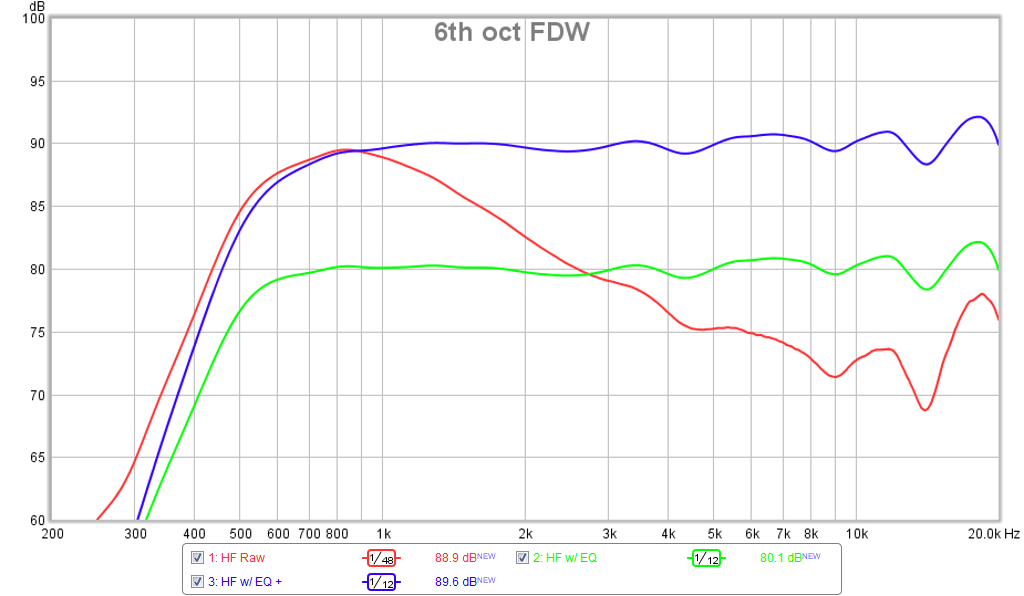
The miniDSP EQ settings used to do this are shown here:
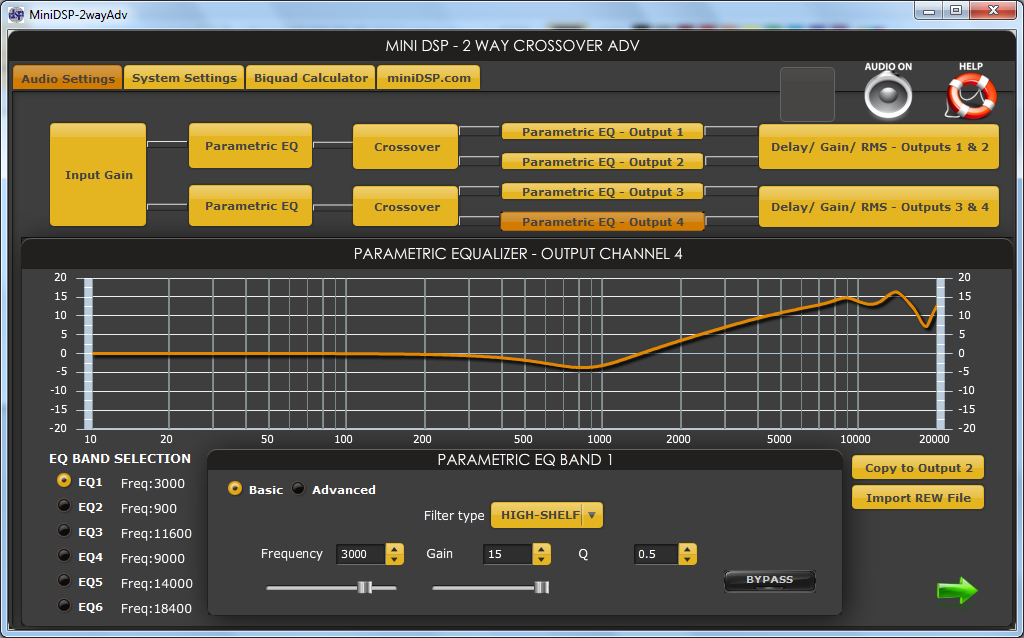
A cut only, no boost approach could have been done, and that may be better. I am still experimenting, but this is first cut EQ.
Here is the measured phase with 6th octave FDW:
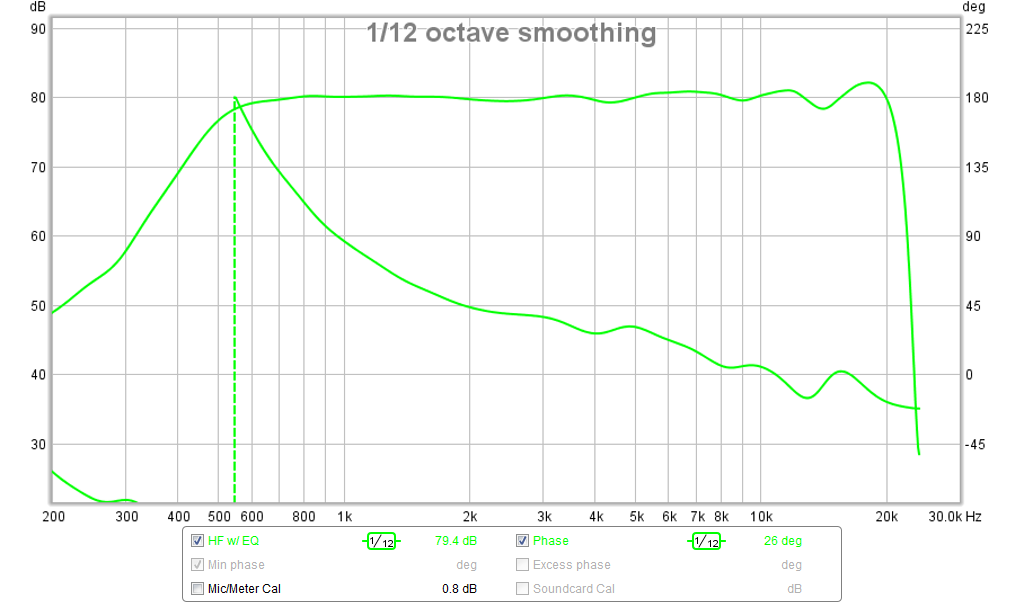
This is the measured impulse before EQ:
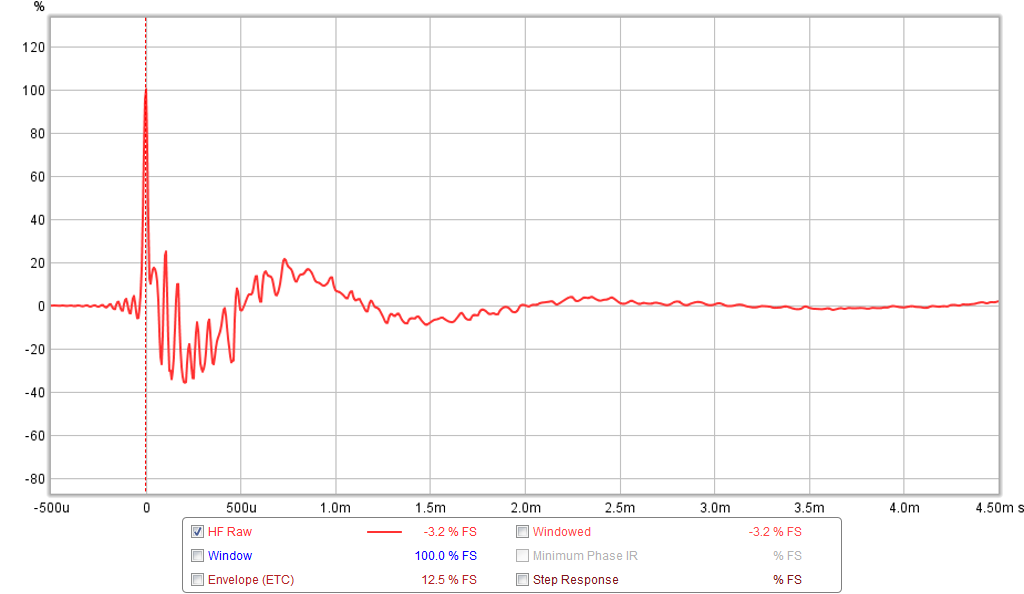
Impulse after EQ:
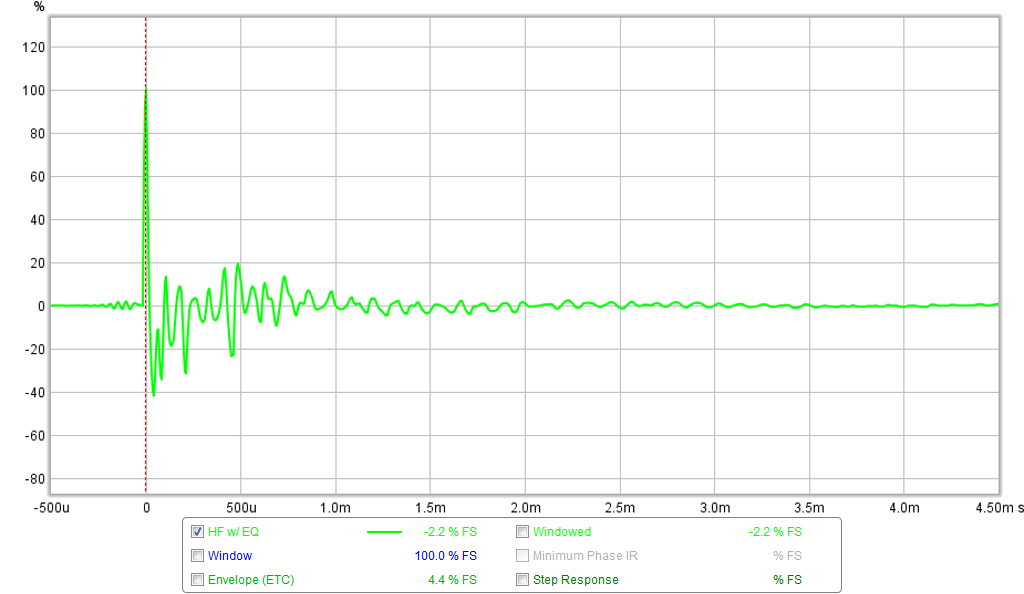
Here is the measured distortion for 90dB at 0.5m with 500Hz LR4 HPF:
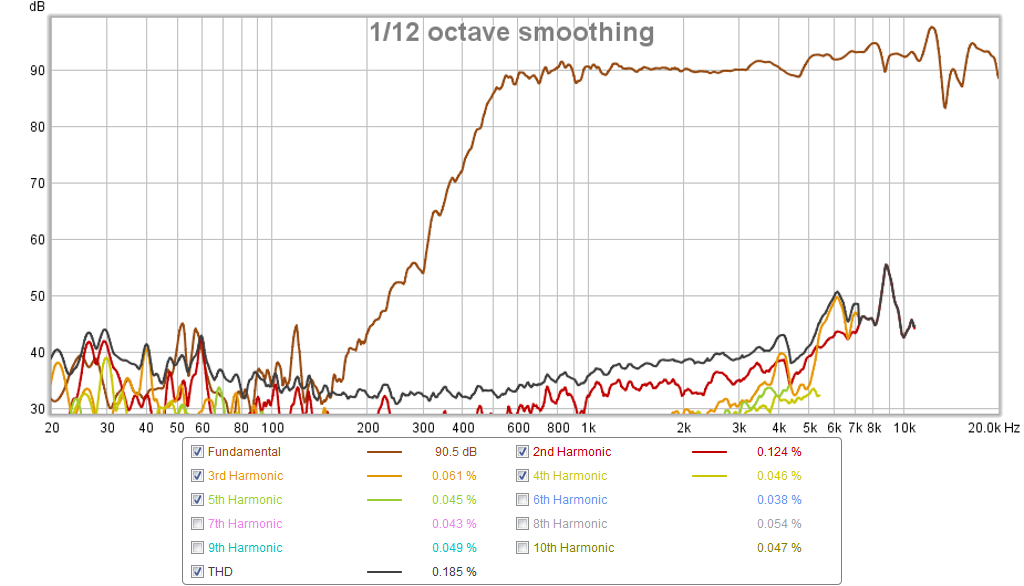
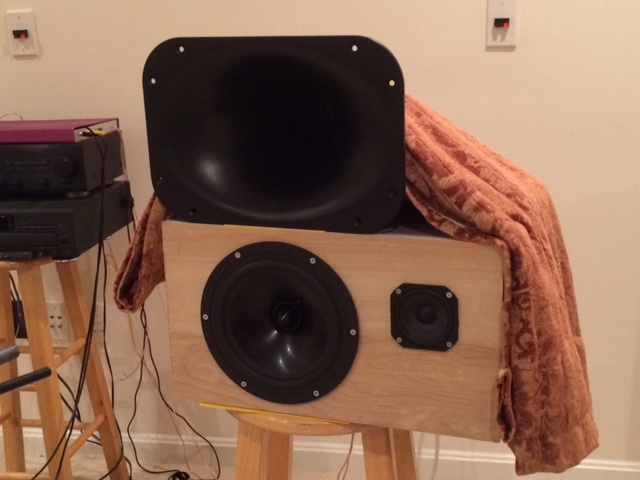
For grins I wanted to get a sense of how music sounds on it so I put together a FAST with the sealed 14 liter RS225-8 as a woofer. Here is the measured acoustic XO using a simple symmetric LR4 at 500Hz:
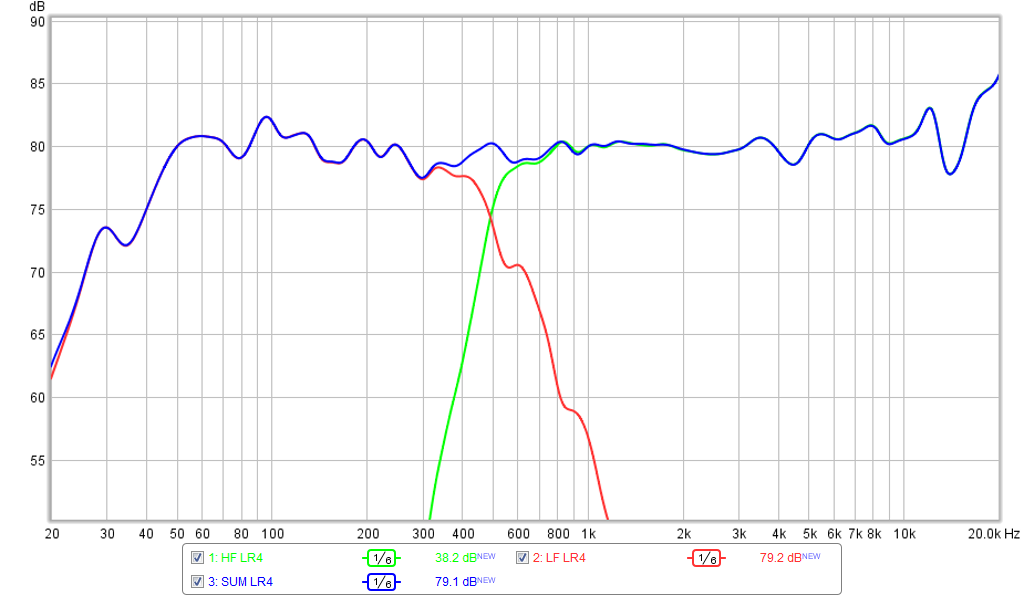
I listened to a few tracks of vocals to assess the midrange purity, some pop, and it sounds quite nice. Very clean and lifelike.
Here is the SB65WBAC25-4 in the Faital Pro LTH142 waveguide with the long throat adapter, now EQ'd to be flat within 6th octave FDW gating:

The miniDSP EQ settings used to do this are shown here:

A cut only, no boost approach could have been done, and that may be better. I am still experimenting, but this is first cut EQ.
Here is the measured phase with 6th octave FDW:

This is the measured impulse before EQ:

Impulse after EQ:

Here is the measured distortion for 90dB at 0.5m with 500Hz LR4 HPF:


For grins I wanted to get a sense of how music sounds on it so I put together a FAST with the sealed 14 liter RS225-8 as a woofer. Here is the measured acoustic XO using a simple symmetric LR4 at 500Hz:

I listened to a few tracks of vocals to assess the midrange purity, some pop, and it sounds quite nice. Very clean and lifelike.
Attachments
-
 SB65-LTH142-RS225-LR4-500Hz-FAST.png63.7 KB · Views: 681
SB65-LTH142-RS225-LR4-500Hz-FAST.png63.7 KB · Views: 681 -
 SB65-RS225-FAST.png389.8 KB · Views: 896
SB65-RS225-FAST.png389.8 KB · Views: 896 -
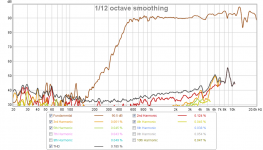 SB65-LTH142-EQ-LR4-500Hz-THD-90dB-0.5m.png116.5 KB · Views: 2,417
SB65-LTH142-EQ-LR4-500Hz-THD-90dB-0.5m.png116.5 KB · Views: 2,417 -
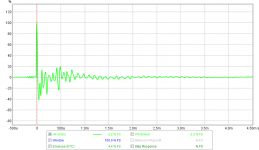 SB65-LTH142-EQ-IR.png54.7 KB · Views: 694
SB65-LTH142-EQ-IR.png54.7 KB · Views: 694 -
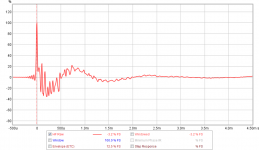 SB65-LTH142-RAW-IR.png54.8 KB · Views: 694
SB65-LTH142-RAW-IR.png54.8 KB · Views: 694 -
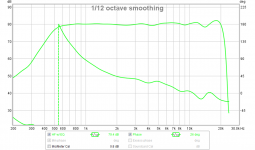 SB65-LTH142-EQ-Phase.png64.7 KB · Views: 1,837
SB65-LTH142-EQ-Phase.png64.7 KB · Views: 1,837 -
 SB65-LTH142-RAW-vs-EQ.png70.9 KB · Views: 1,854
SB65-LTH142-RAW-vs-EQ.png70.9 KB · Views: 1,854 -
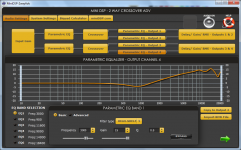 miniDSP-EQ-SB65.png132.7 KB · Views: 1,882
miniDSP-EQ-SB65.png132.7 KB · Views: 1,882
Last edited:
After many tests with a short (0.30in), medium (0.625in), and long (1.00in) throat adapters with the FR58EX, I could not get the 9kHz dip to go away. I should have realized it probably was a cone resonance thing going on as the impulse just looked horrid.
Finally, switched to the SB65 in the medium adapter using a simple foam core gasket to keep the surround from bumping the adapter and the results looked promising as the 9kHz dip went away. The gasket was a bit small so the surround was rubbing the gasket at lower frequencies and causing the distortion to really increase.
Here is a photo of the SB65 as mounted to the long adapter on the Faital Pro LTH142 wave guide:
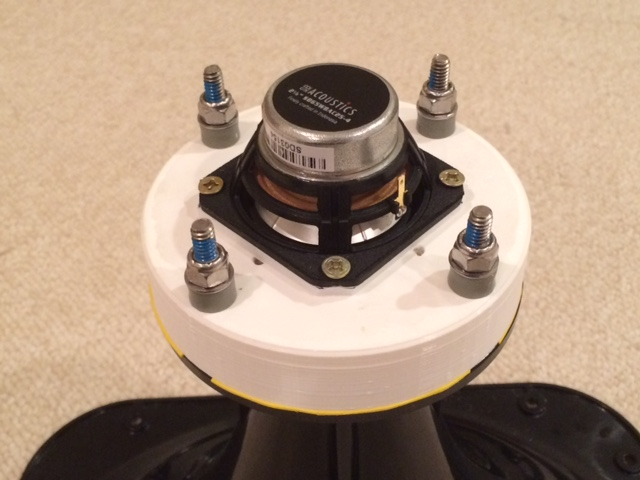
Here is a model of the long thhroat adapter so you can see the profile:
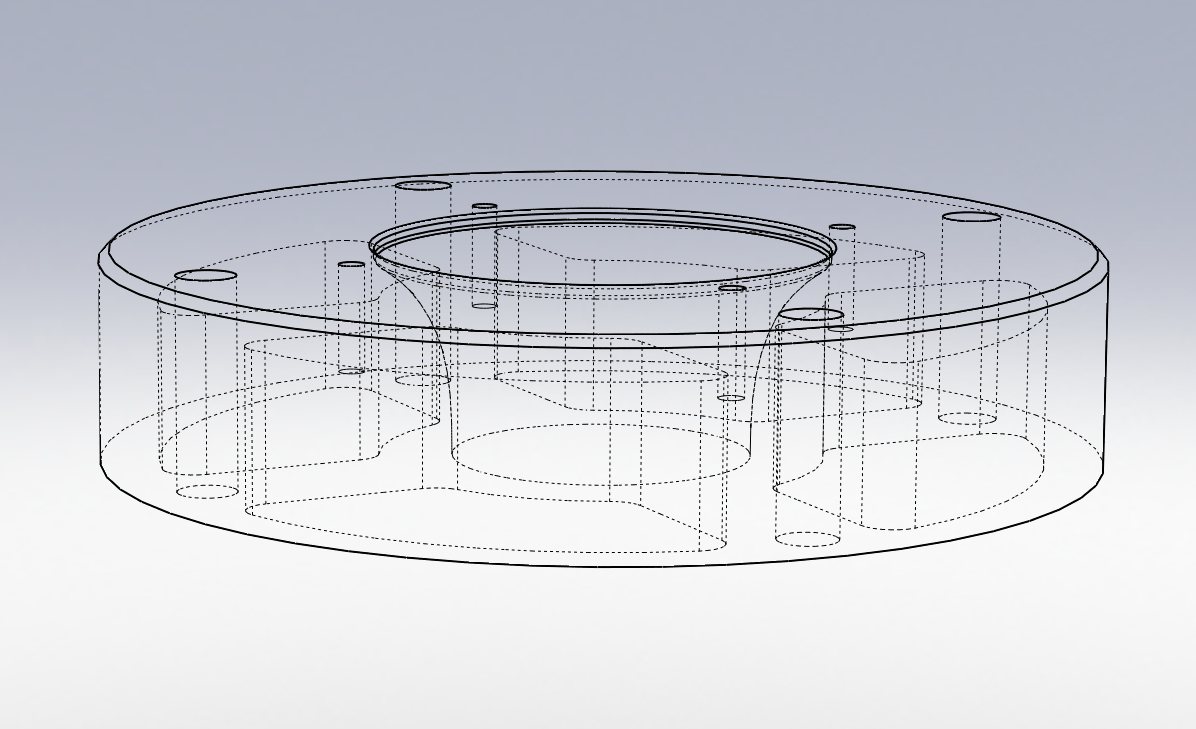
Here is a comparison of the various throat adapters, there is still a small dip near 9kHz, but it's only 5dB, and when viewed in frequency dependent gating at 1/6th octave, the dip is not there:
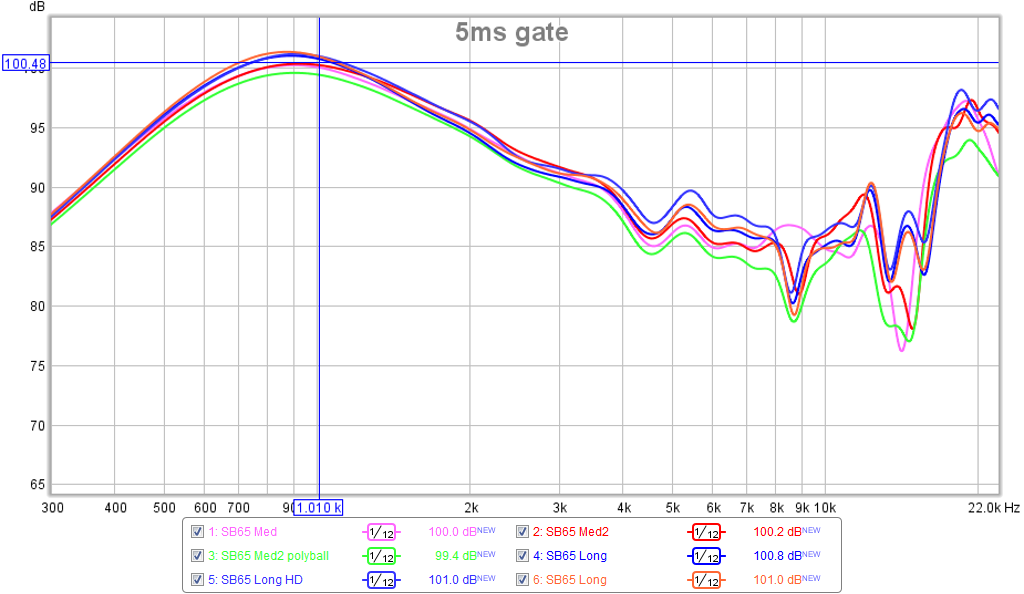
I then switched to the long throat for the remainder of the measurements. The long throat adapter uses a gentle spline curve rather than a radius, I also made a new gasket so the surround doesn't rub, and the test shows it has the smoothest performance and best looking phase. The phase, although not flat, is well behaved and once some PEQ is applied, I expect it to flatten out substantially:
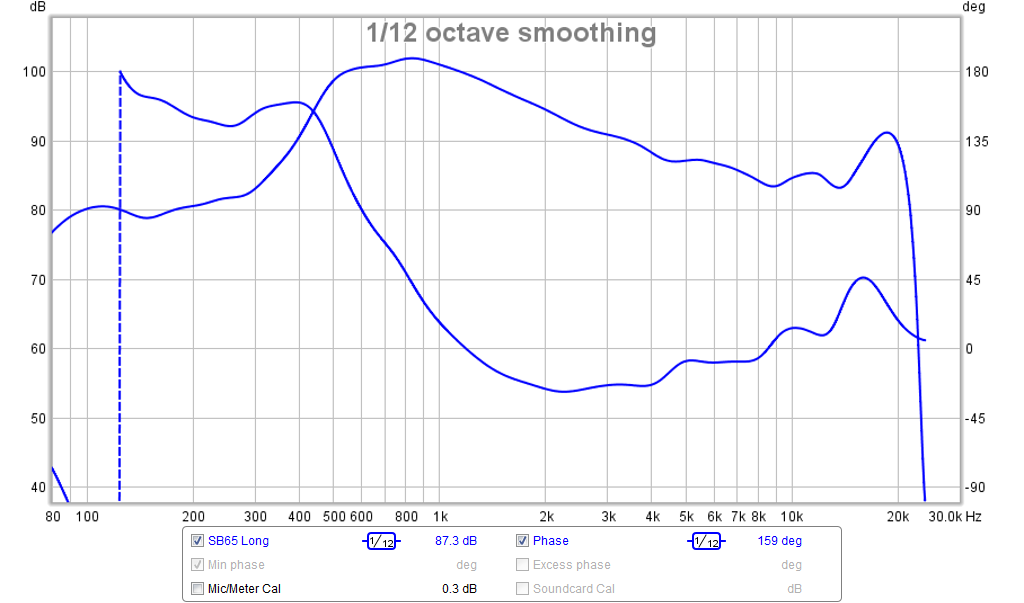
Here is the harmonic distortion of the SB65 at -6dB from 2.83v at 0.5m:
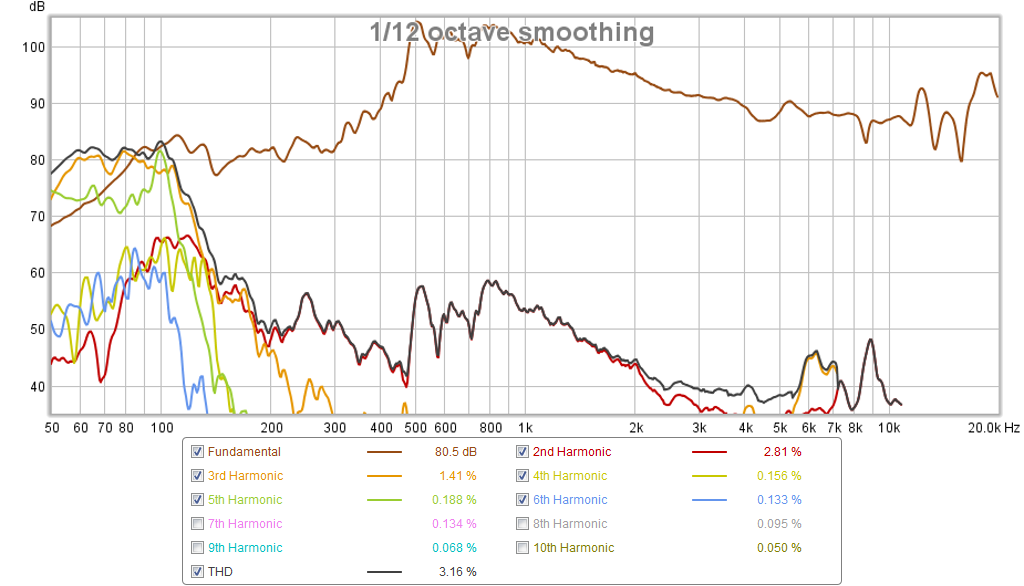
Here is the harmonic distortion measured at 1m, and -5dB down from 2.83v (the cursor was on some random spot, the THD at 1kHz at 97dB was about 0.5%):
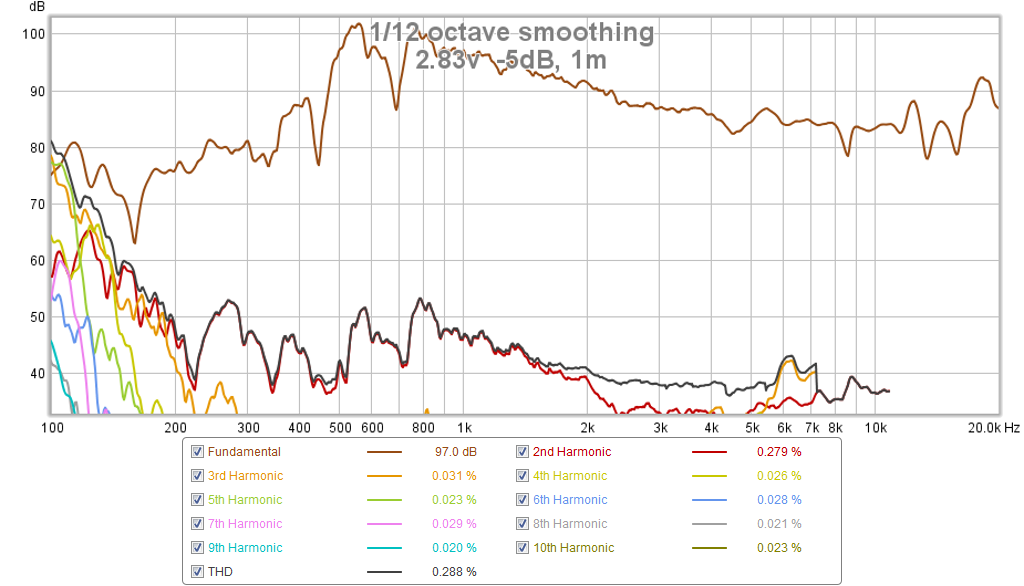
Here is the RTA looking at a 1kHz sine wave to see the distortion components with horn playing at 100dB (be sure to wear ear plugs when testing):
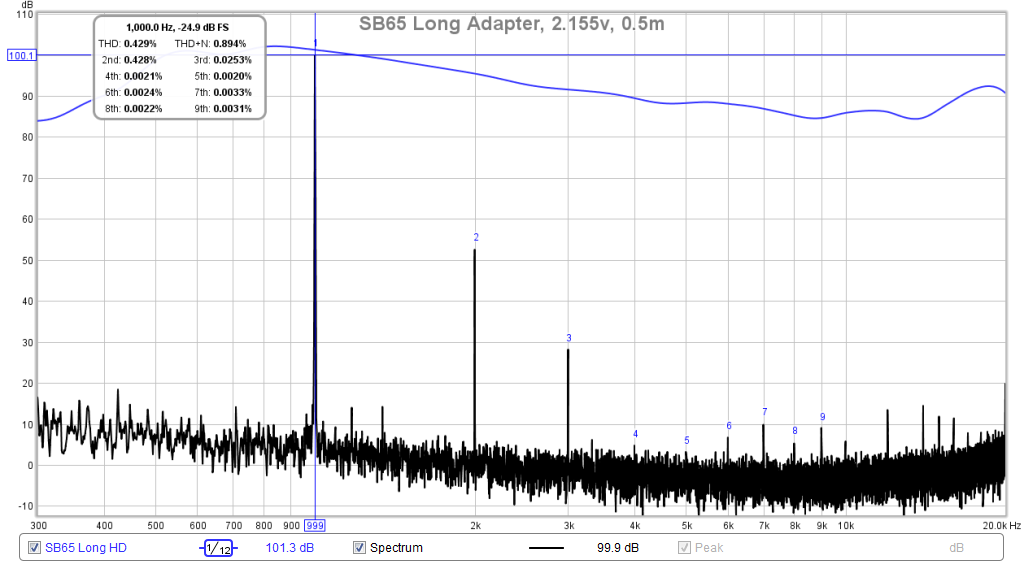
Here is the impulse response of the SB65 with the long adapter:
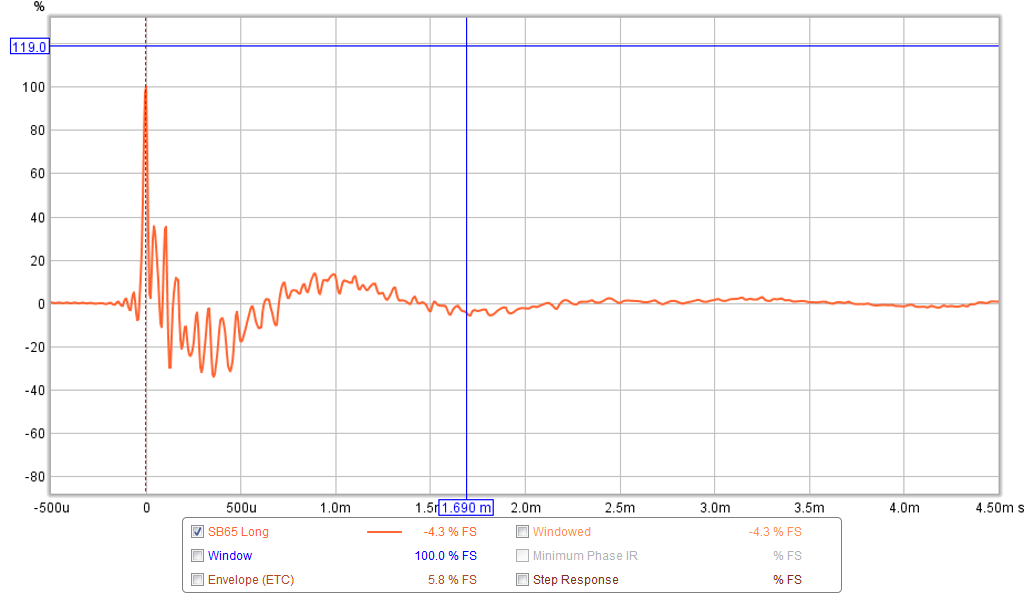
X think you're already on the right track.
The new long adapter you built seems have been successful.
Still I think maybe I should be rather more space (one air chamber 2-3 mm) around and in front of the damper in setting the driver to avoid any possible compression (airflow) exerted by the walls the inlet adapter and may interfere in the free movement of the driver cone.
This is corroborated by the excellent work Burnsmaster done with a small joint applied to about 2 mm from around the cushion of driver and together and with the air camera that got when outing the driver with the adapter he built on epoxy to enter mouth of the horn .
Burns got a big enough air camera to the output driver while the adapter is very progressive (and minimal funnel) and also all buid at minimum space.
Any case everything I said is speculation and trial and error here is imposed to find the optimal solution and I only said this if would serve someone these ideas becuase I think that do a good job in the adapter part is critical for the best result.
But X you've got it. Your data is also outstanding!.
Totally agree that the SB65 is more suitable for this application.
Regards
What do you guys think of using the P.audio ph-2380 in such an application?
More info later in weekend these two P. Audio model 2823/4528 2 inchers (post 483) http://www.diyaudio.com/forums/mult...lti-way-point-source-horn-49.html#post4590004. Have TC9 and 10F for exercise and will receive a pair SB65 probably on Tuesday.
Last edited:
In first months running repaired XO phase turn distortion preferred having system stop bands as IRR phase roll offs as in picture 3 plot and as also wesayso prefer in his setup, but after Barleywater made some comments my system and got better to tune into acoustic target slopes and handle the software had run full linear phase as in picture 4 plot several months. Experience for flat phase is realism in sound and also better speech recognition.
Harsch compared LR has some amplitude and phase ripple, that said think its looks great and we should keep eye in bushmeisters build if it suit multiway point source to throw better polars and flat phase than other XO config would do, but lets see when woofer number two is added and they gets sealed or leaking enclosure on cones backside.
The flat Fr and Phase of Bushmeister's setup makes me think he's not having a true Harsch x-over as we know it. Way too coherent both in phase and FR.
I said it before and stand by it. Forget about names in crossovers and let them do the best job possible. To me bushmeisters attempt seems to do just that.
We might want to look at phase and FR under all angles to be sure.
BYRTT, you're not being entirely fair to me. Yes I stated I want the minimum phase over the entire bandwidth. But my system doesn't exactly roll off at 100 Hz now, does it? 😉
It is flat phase down to 40 Hz, the difference is in the area below 40 Hz. I hear a difference between linear and minimum phase for that last bit of a turn.
The linear phase sounds a bit "hasted" and "pressured", the minimum phase sounds more natural. It has extension in SPL down to 17 HZ at least. I think that makes a difference 🙂.
In other words, the linear phase correction makes me feel "jumpy". Like I'm trying to catch a bus or a train...
Last edited:
Bushmeister used REW auto EQ and I did manual. I wonder of it was the auto tune that helped him get flatter phase. My phase is aril tilted.
Or is that the waveguide design? The 18Sound is some super elliptic vs mine is a tractrix?
Or is that the waveguide design? The 18Sound is some super elliptic vs mine is a tractrix?
X, judging from your curve, if you'd choose the Average output at 2.5 or 3 KHz as a base, cut the low end and raise the top end by keeping that average a2 2 KHz that might make a difference. Makes sense?
Just checked the EQ plot from bushmeister, it seems that's what he (or REW) did:
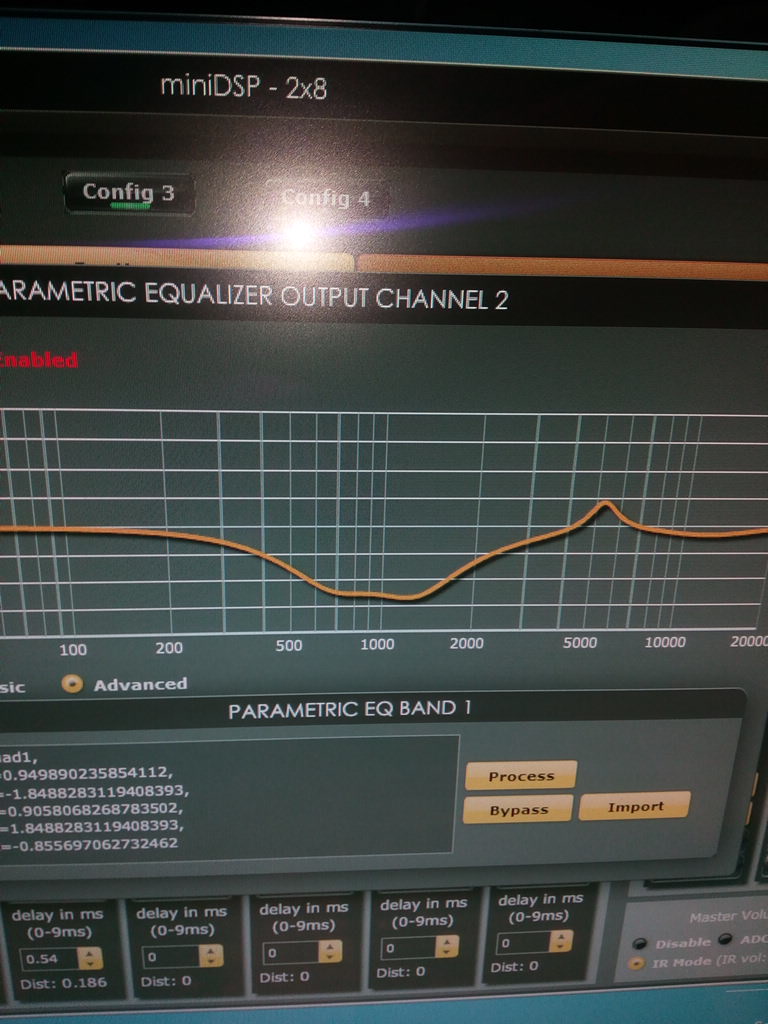
In comparison your plot seems to use ~1.5 KHz as the reference.
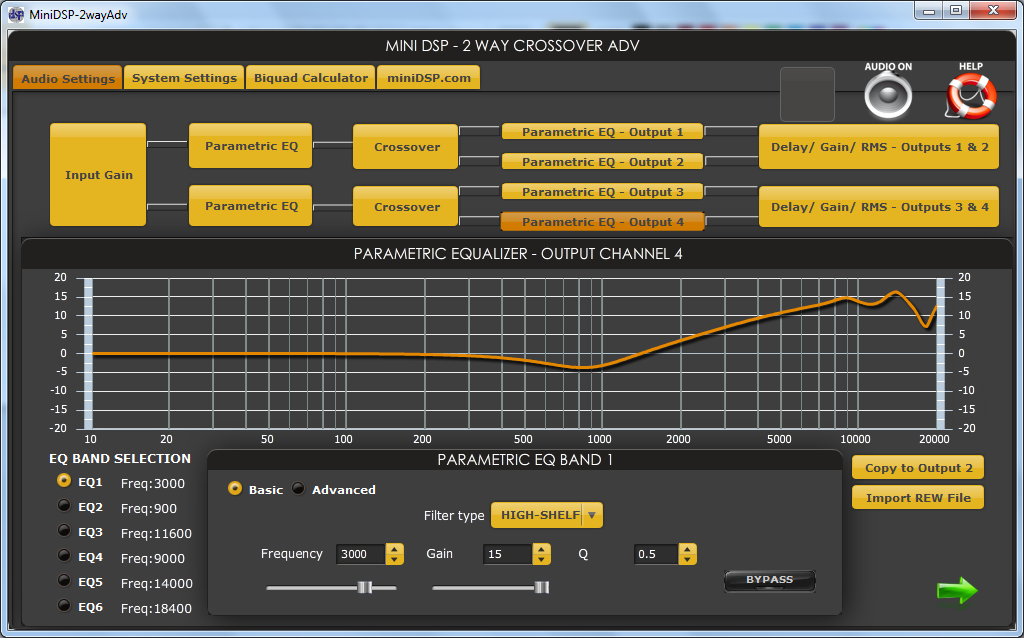
I'm thinking the level at which you straighten the SPL is the key here... It might even be that bushmeister is mostly cutting if we see the line out in the left part. If that is the zero line than a big cut was used and only a small boost at ~6 KHz.
Just checked the EQ plot from bushmeister, it seems that's what he (or REW) did:

In comparison your plot seems to use ~1.5 KHz as the reference.

I'm thinking the level at which you straighten the SPL is the key here... It might even be that bushmeister is mostly cutting if we see the line out in the left part. If that is the zero line than a big cut was used and only a small boost at ~6 KHz.
Last edited:
Thanks, I suspected that too. Will give it s try later today. Getting hit with the mother of all snow storms now on Eastern seaboard.
- Home
- Loudspeakers
- Multi-Way
- A Bookshelf Multi-Way Point-Source Horn
